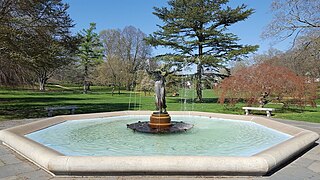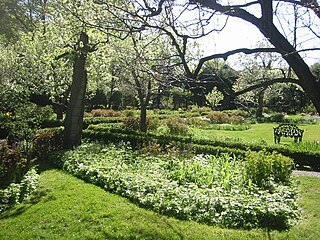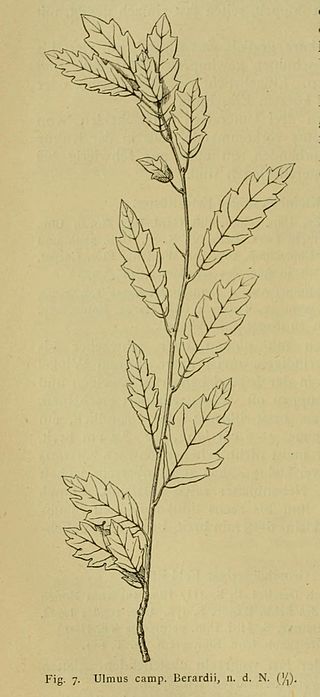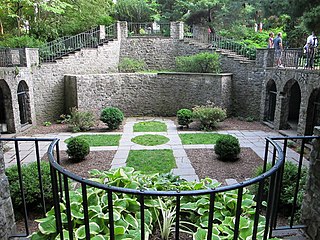
The Arnold Arboretum of Harvard University is a botanical research institution and free public park, located in the Jamaica Plain and Roslindale neighborhoods of Boston, Massachusetts. Established in 1872, it is the oldest public arboretum in North America. The landscape was designed by Charles Sprague Sargent and Frederick Law Olmsted and is the second largest "link" in the Emerald Necklace. The Arnold Arboretum's collection of temperate trees, shrubs, and vines has an emphasis on the plants of the eastern United States and eastern Asia, where arboretum staff and colleagues are sourcing new material on plant collecting expeditions. The arboretum supports research in its landscape and in its Weld Hill Research Building.

The Botanic Garden of Smith College is located on the campus of Smith College, in Northampton, Massachusetts, United States. It consists of a fine selection of woody trees, shrubs, herbaceous plants, and an excellent collection of tropical and subtropical plants in The Lyman Conservatory. All are open to the public.
The Buffalo and Erie County Botanical Gardens are botanical gardens located within South Park in Buffalo, New York, United States. These gardens are the product of landscaping architect Frederick Law Olmsted, glass-house architects Lord & Burnham, and botanist and plant-explorer John F. Cowell.

Wilcox Park is a park and arboretum located at 44 High Street, Westerly, Rhode Island. It is open to the public from dawn to 9 pm, without fee, and has been on the National Register of Historic Places since 1973 as Wilcox Park Historic District. The historic district includes 84 houses/buildings of the neighborhood surrounding the park covering a 50-acre (20 ha) area, including the main post office and library within the town of Westerly.
The University of Rochester Arboretum is an arboretum located across the River Campus of the University of Rochester, 612 Wilson Boulevard, Rochester, New York.

Ellwanger Garden is a historical garden located at 625 Mt. Hope Avenue, Rochester, New York. It is open only during the Lilac Festival (May), Peony Weekend (June), and by appointment.

The Oregon Vietnam Veterans Memorial is an 8-acre (0.03 km2) outdoor war memorial dedicated to Oregonians who served in the Vietnam War. It is located in Portland, Oregon's Washington Park at 45.5120°N 122.71857°W. The memorial was dedicated in 1987, inspired in 1982 by visits to the national Vietnam Veterans Memorial by five veterans and the parents of a Marine killed in Vietnam. Landscape architecture firm Walker Macy of Portland designed the memorial, while construction labor and materials were almost entirely volunteer donations.The font used in the memorial was created for the exclusive use of the Memorial. It was designed by Janis Price, and is called Hoyt, in recognition of the Arboretum.

The Rochester Lilac Festival is an art, music, food and flora festival hosted annually in early May in Highland Park in Rochester, New York. Highland Park possesses a huge collection of lilacs, featuring more than 1800 bushes and over 500 different varieties.

The hybrid elm cultivar Ulmus × hollandica 'Dampieri', one of a number of cultivars arising from the crossing of the Wych Elm U. glabra with a variety of Field Elm U. minor, is believed to have originated in continental Europe. It was marketed in Wetteren, Belgium, in 1851 as 'Orme de Dampier', then in the Low Countries in 1853, and later identified as Ulmus campestris var. nuda subvar. fastigiata DampieriHort., Vilv. by Wesmael (1862).

The elm cultivar Ulmus 'Berardii', Berard's Elm, was raised in 1865, as Ulmus Berardi, from seeds collected from large specimens of "common elm" growing on the ramparts at Metz, by an employee of the Simon-Louis nursery named Bérard. Carrière (1887), the Späth nursery of Berlin and the Van Houtte nursery of Gentbrugge regarded it as form of a Field Elm, listing it as U. campestris Berardii, the name used by Henry. Cheal's nursery of Crawley distributed it as Ulmus nitens [:Ulmus minor] 'Berardii'. Smith's of Worcester preferred the original, non-specific name, Ulmus 'Berardii'.
The putative Wych Elm cultivar Ulmus glabra 'Dovaei', or Doué elm, was raised by the André Leroy nursery at Angers, France, as Ulmus dovaei, before 1868. The Baudriller nursery of Angers marketed it as Ulmus Dowei, "orme de Doué", suggesting a link with the royal nurseries at nearby Doué-la-Fontaine, which stocked elm. Green considered it a form of wych.

The dwarf wych elm cultivar Ulmus glabra 'Nana', a very slow growing shrub that with time forms a small tree, is of unknown origin. It was listed in the Simon-Louis 1869 catalogue as Ulmus montana nana. Henry (1913), referring his readers to an account of the Kew specimen in the journal Woods and Forests, 1884, suggested that it may have originated from a witch's broom. It is usually classified as a form of Ulmus glabra and is known widely as the 'Dwarf Wych Elm'. However, the ancestry of 'Nana' has been disputed in more recent years, Melville considering the specimen once grown at Kew to have been a cultivar of Ulmus × hollandica.
The Field Elm cultivar Ulmus minor 'Microphylla Pendula', the Weeping small-leaved elm, was first listed by the Travemünde nursery, Lübeck, and described by Kirchner in Petzold & Kirchner's Arboretum Muscaviense (1864), as Ulmus microphylla pendulaHort.. By the 1870s it was being marketed in nurseries in Europe and America as Ulmus campestris var. microphylla pendula.

The Veterans Memorial Bridge in Rochester, New York, carries New York State Route 104 across the Genesee River. The bridge is an architecturally significant concrete arch faced with white granite. Conceived in 1928 and finished in 1931, the span is the longest bridge in Rochester at 981 feet (299 m). It is 190 feet (58 m) in height and 106 feet (32 m) wide.

George Ellwanger was a German-American horticulture scientist.

Mt. Hope–Highland Historic District is a national historic district located at Rochester in Monroe County, New York. Its encompassed by the neighborhoods of Mount Hope and Highland Park. It has a diverse range of architectural styles. The district was the exclusive domain of the Ellwanger and Barry Botanic Gardens and Mt. Hope Cemetery throughout the mid- and late-19th century. It retains its elegant and spacious character of park land.

The Field Elm cultivar Ulmus minor 'Monumentalis', the tomb elm (Grabmal-Rüster), was raised as a sucker of U. suberosa by Sebastian Rinz, the city gardener of Frankfurt, before 1855 and listed by the Jacob-Makoy nursery of Liège in their 1861 catalogue as Ulmus monumentalisRinz, "a new variety". Kirchner (1864) described it, confirming that it had only recently been propagated by Rinz and established in the nursery. It was distributed from the 1880s by the Baudriller nursery, Angers, and by the Späth nursery, Berlin, as U. campestris monumentalisRinz., appearing separately in their catalogues from U. minor 'Sarniensis', the Guernsey or Wheatley Elm, with which, according to Henry, it was confused on the continent. Krüssmann, for example, gives 'Monumentalis' as a synonym of 'Sarniensis'. 'Sarniensis' is known as monumentaaliep [:monumental elm] in The Netherlands. Springer noted that the Dutch monumentaaliep was "not the actual monumentaaliep but U. glabraMill.var. Wheatleyi Sim. Louis", and that it "should be renamed U. glabraMill. var. monumentalisHort.(non Rinz)". In England, Smith's of Worcester listed Ulmus monumentalis separately from Ulmus 'Wheatley' in the 1880s.

The wych elm cultivar Ulmus glabraHuds. 'Superba', Blandford Elm, with unusually large leaves, was raised by Gill's of Blandford Forum, Dorset, in the early 1840s as Ulmus montana superba and was quickly distributed to other UK nurseries. It was confirmed as a form of wych, and first described by Lindley in The Gardeners' Chronicle, 1845, later descriptions being added by Gill (1845) and Morren (1848), who called it U. montana var. superba. Morren had adopted the name 'Superba' from the Fulham nurseryman Osborne in 1844, who supplied him with the tree – presumably one of the nurseries supplied by Gill. Morren states that 'Superba', already in cultivation in England, was introduced to Belgium by Denis Henrard of Saint Walburge, Liège, that in 1848 it had been present in Belgium for only three years, and that this variety was the one described as 'Superba' by Osborne, whom Henrard had visited at his nursery in Fulham in September 1844. 'Blandford Elm', with leaves of the same dimensions, was soon for sale in the USA.

A statue of Frederick Douglass sculpted by Sidney W. Edwards, sometimes called the Frederick Douglass Monument, was installed in Rochester, New York in 1899 after it was commissioned by the African-American activist John W. Thompson. According to Visualising Slavery: Art Across the African Diaspora, it was the first statue in the United States that memorialized a specific African-American person.




















